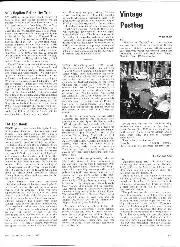
The log book
ONCE upon a time the vehicle log-book was an important document. We were instructed to keep it in a safe place and not to buy a vehicle unless it was…
GLIDING LKCTURK
ON the 19th of last month a lecture was delivered before the Royal Aeronautical Society in London by Dr. Walter Georgii, and Herr Fritz Stainer, on gliding at the flying school at Wasserkuppe, Germany.
As was to be expected the lecture was extremely interesting and instructive and attracted a large number of visitors. Dr. Georgii traced the history of the glider movement in Germany from 1920 and graphically illustrated by lantern slides and with statistics the striking advance which has been made in motorless flight during the past 10 years. One feature which impressed listeners in particular was the amount of work which the research department of the school at Wasserkuppe carries out in the scientific investigation of air currents, conditions at varying altitudes, cloud formations and so forth. Their findings in this direction have been of great value to both designers and pilots of sail planes and it is safe to say that the data acquired has contributed largely to the progress which has been made. Herr Stamer’s paper dealt at length with the formation, organisation and methods of instruction of the school at Wasserkuppe, where in a session of seven months between 200 and 250 pupils pass through a course. Fifteen gliders and sail planes of five different
types are in u.se by the school. These include : six Zoglings, for beginners, three Pruflings for soaring practice, two Hangwinds for soaring in light winds, two Canossa two-seaters and two high performance sail planes of the Professor type.
In initial training the pupil carries out short hops only and he is watched by the instructor from the ground ; afterwards he is launched from a hilltop and at a later stage, passes onto the Prufling machine. Herr. Stainer stated the dual control instruction had been tried with success, but owing to the complication in construction entailed and the extra call on instructors’ time it has not been widely adopted. It was also pointed out that a two-seater with a low wing loading and a good gliding angle has of necessity to be of very big span which of course is undesirable.
When pupils pass onto the soaring plane proper they start with making long, flat figure of eight turns in the region of a rising wind and in this way develop a ” soaring sense.”
The lecture concluded with the exhibition of a film showing the different types of machines in flight, method of launching, various phases of the construction of gliders and views of the Wasserkuppe school ground.